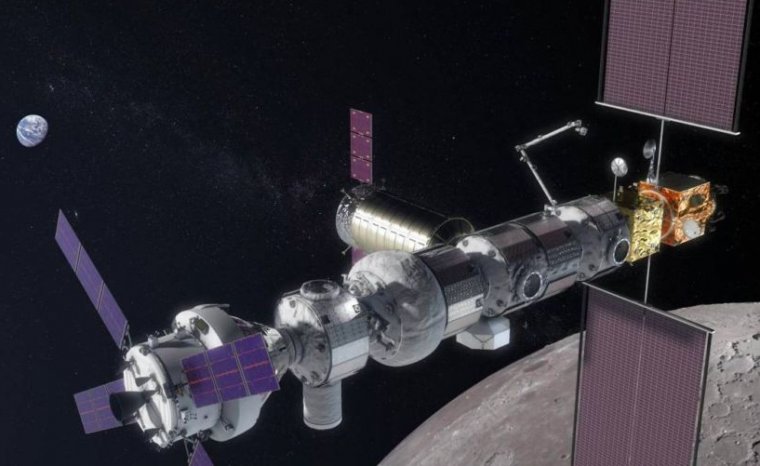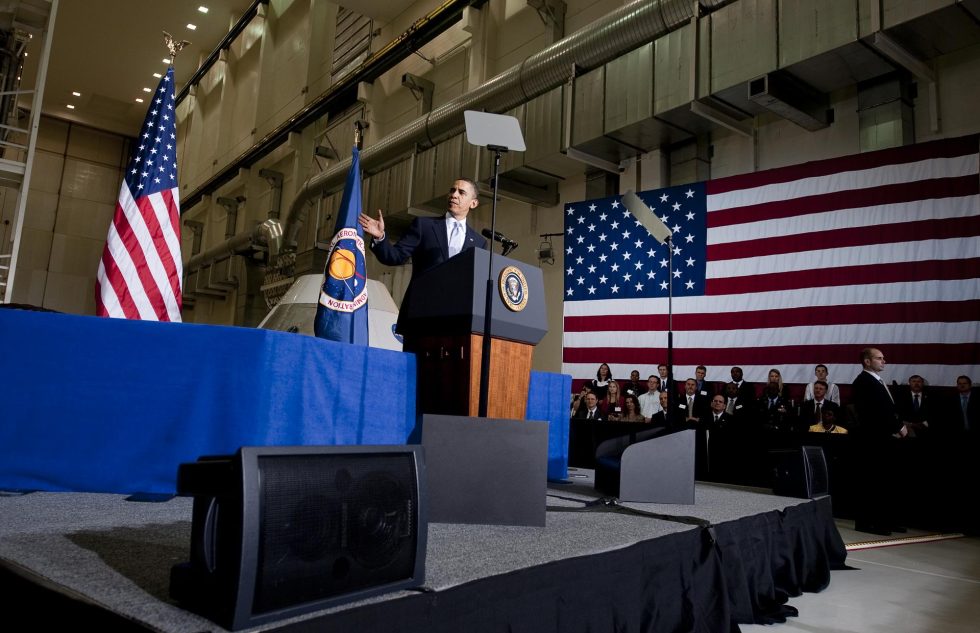
NASA
It is the year 2026. A veteran astronaut, Nicole Mann, leads her crew of four through a hatch from the Orion spacecraft onto a small space station near the Moon. Inside, it smells something like a new car. Outside, all is splendor. Below the station, half of the Moon reflects the sunlight—shimmering, silvery, and silent. The depths of space blacken the other half of the orb. In the distance, a blue and green Earth also basks in the Sun’s glow. Humanity’s cradle and its future among the stars share the vista.
The 49-year-old Mann, who goes by the call sign “Duke,” begins a series of communications checks. There is a two-second delay before Mission Control responds with cheers and high fives. For decades after Apollo, humans had remained confined in low-Earth orbit. No more. After Mann’s crew spends a dozen days outfitting the new “Gateway” in orbit around the Moon, NASA will finally have a toehold in deep space again. From here, humans may soon go down to the lunar surface or make final preparations for missions to Mars.
Such a future scenario, at least, is what the space agency wants Congress, the White House, and the American public to imagine when envisioning a lunar space station, which NASA proposes to build in the 2020s. “I think about it as a port in space, a dry dock for activities that come and go,” said Jason Crusan, a senior NASA official from headquarters overseeing development of the Gateway.
Over the last three years, Crusan and other leaders of human exploration at NASA have quietly refined plans for the Gateway and, perhaps more importantly, crafted a rationale to build the outpost near the Moon. So far, their plan has worked. Vice President Mike Pence has endorsed the Gateway, as has the new NASA administrator, Jim Bridenstine.
“There’s no other architecture that I’ve been presented with, given the current budgets we have, that enables all of what we want to do,” Bridenstine recently told Ars. “And so I came to the conclusion that the Gateway is the right approach.”
NASA, too, has won over the lion’s share of aerospace contractors and their vast lobbying armies by offering contracts for six different designs for the Gateway’s habitat module. Moreover, agency officials have repeatedly said they would invite commercial companies like SpaceX to deliver cargo and provide other services for the station. Almost everyone stands a reasonable chance of getting a piece of the Gateway action.
This has not left much oxygen in the room for dissenters—publicly, at least. However, a few critics persist, and they raise valid questions about the lunar Gateway. Robert Zubrin, a high-profile aerospace engineer outside of NASA’s policymaking process, has emerged as a chief antagonist.
-
What is the lunar Gateway? These charts shared by NASA officials at a meeting of the National Space Council in late August offer the most public detail to date.
NASA
-
This graphic shows a bit more about different elements NASA envisions for the Gateway. Note the element (E) is mis-colored. It should be blue as it will be a US contribution.
NASA
-
More detail about the early modules.
NASA
-
The first piece will be a power and propulsion element.
NASA
-
Sometime in the mid-2020s, NASA will add a large habitat to the Gateway. It will be based on one of these six commercial concepts.
NASA
-
Some of the objectives of the Gateway program.
NASA
“It is the next giant leap into quicksand,” Zubrin argued during a recent meeting of The Mars Society. “If you wanted to send people to the Moon or Mars, would you take some of your money to build a lunar orbit space station on the way? You would not.”
Zubrin and others argue that the Gateway exists not to smooth NASA’s way to the Moon or Mars, but rather to provide a destination for the agency’s expensive rocket, the Space Launch System, and Orion spacecraft. These vehicles, built for NASA by large aerospace firms with hundreds of subcontractors around the country, cannot presently go to the Moon or Mars. Combined, they’re just not powerful enough. NASA has struggled for the better part of a decade to find something for them to do. And after wandering in the wilderness, agency leaders finally settled on the Gateway concept.
“Let’s be honest about this,” Zubrin said of NASA's human exploration plans. “This is not a purpose-driven program, this is a vendor-driven program. Imagine running your business to please your vendors.”
Getting to Gateway
One need not regurgitate decades of space policy history to understand why NASA now espouses development of a lunar Gateway that will cost at a minimum $10 billion and almost certainly many multiples of that. Still, a little background helps.
The short synopsis is this: in 2004, George W. Bush wanted to send humans back to the Moon and on to Mars. NASA engineers, led by Administrator Mike Griffin, responded by devising a large, expensive system to accomplish this that was never properly funded. When Barack Obama became president, he canceled the human return to the Moon, because it was woefully behind schedule and unaffordable, and the president urged cancellation of Griffin’s large rocket and spacecraft. Leery of losing jobs and NASA’s institutional knowledge, Congress pushed back hard on Obama. While the Moon remained off the table, NASA was told to build a big rocket, now redesigned as the Space Launch System, and to continue with the Orion spacecraft.
This left a big problem. What to do with SLS and Orion? Critics came to call the SLS a “rocket to nowhere,” because NASA had no clear need for it. Sure, the rocket and spacecraft could fly around the Moon, in a repeat of NASA’s 1968 Apollo 8 mission, but it could not land on another world with gravity.
Eventually, the Obama administration solved this problem with a new destination, suggested by a blue-ribbon panel known as the Augustine commission. “By 2025 we expect new spacecraft designed for long journeys to allow us to begin the first-ever crewed missions beyond the Moon into deep space,” Obama said at Florida’s Kennedy Space Center in 2010. “So we’ll start by sending astronauts to an asteroid for the first time in history.”
At first, this seemed like a great idea. An asteroid offered a new destination, and it also had the critical benefit of a shallow gravity well. NASA could go there without having to build expensive landers and ascent vehicles, which it could not afford due to SLS and Orion’s outsized costs (more than $3 billion a year).

NASA
Unfortunately, after searching for a few years, scientists could not find a suitable asteroid that came close enough to Earth for astronauts to reach it in a timely manner, as the Orion vehicle could only support a crew for 21 days in deep space. NASA concluded that it lacked the budget and tools to send humans to an asteroid by 2025—or really, any date for a long, long time.
So around the middle of this decade, the agency’s clever engineers devised a plan that was both feasible and technically met the president’s goal of visiting an asteroid by 2025. While elegant in these regards, the mission was something of a sham. The “Asteroid Redirect Mission” called for the agency to fly a robotic spacecraft out into the Solar System, grab an SUV-sized boulder off the surface of an asteroid, and bring it back to the vicinity of the Moon. Astronauts would then visit it in 2025 via Orion. It was clear this mission would be canceled long before Obama left the White House.
Therefore, around three years ago, with NASA having spent the better part of $20 billion (and counting) to develop SLS and Orion, the agency still needed something to do with these vehicles.
Over time, engineers at Johnson Space Center, with input from other centers, devised the lunar Gateway. Why not? NASA already knew how to design and build a space station, as it had done with the International Space Station. The new outpost could be placed far enough from the Moon's gravity well such that SLS and Orion could be used to build the Gateway, and when that was done, NASA would be guaranteed an annual SLS rocket launch to deliver crews there for 30- to 60-day missions.
The Gateway solved NASA’s political and technical problems. Therefore as the asteroid mission died an early, unmourned death, the Gateway ascended. This plan provided NASA’s legions of contractors something to work toward, and Gateway elements could be designed such that only the SLS and its larger cargo capability—rather than significantly cheaper, albeit less powerful, rockets—could deliver them into lunar orbit.
All NASA engineers had to do now was come up with a practical use for it.
Listing image by NASA
Read Again NASA says it's building a gateway to the Moon—critics say it's just a gate : https://ift.tt/2wUWZYvBagikan Berita Ini















0 Response to "NASA says it's building a gateway to the Mooncritics say it's just a gate"
Post a Comment